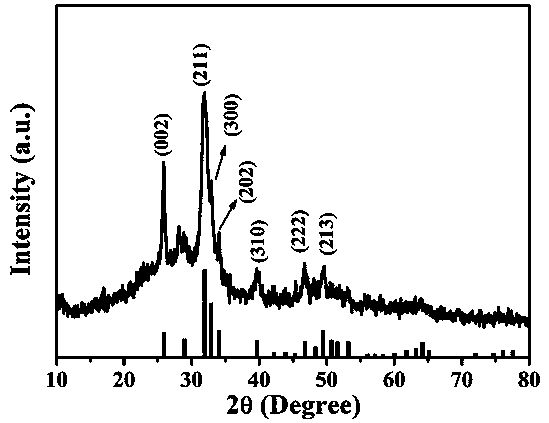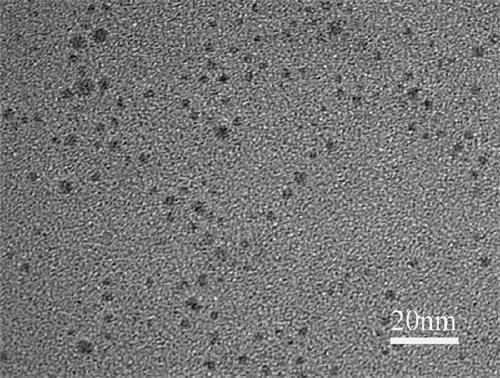A method for preparing hydroxyapatite using red blood cells as a bioreactor
A hydroxyapatite, bioreactor technology, applied in chemical instruments and methods, phosphorus compounds, inorganic chemistry, etc., to achieve the effects of temperature controllable reaction conditions, environmental friendly reaction conditions, and simple operation
- Summary
- Abstract
- Description
- Claims
- Application Information
AI Technical Summary
Problems solved by technology
Method used
Image
Examples
Embodiment 1
[0021] The upper layer of plasma was removed by centrifugation from pig blood whole blood and washed with normal saline for 3 times to obtain red blood cell pellet, and 0.5mL red blood cell pellet was suspended in 5mL containing 40mM CaCl 2 Add 0.5g of glucose to normal saline, react in an ice-water bath for 3 hours, then centrifuge and wash to fully wash away the CaCl outside the cells 2 , the centrifuged cell pellet was collected and resuspended in 5 mL of 24 mM PBS buffer solution with pH=9, placed in a shaker (oscillating speed of 90 rpm) at 10 ° C for 6 h, centrifuged and washed, and finally obtained the hydroxyapatite-containing Functionalized red blood cells are pulverized, separated and purified to obtain hydroxyapatite nanoparticles with an average particle size of 5.6 nm.
[0022] figure 1 It is the XRD spectrum of the hydroxyapatite nanoparticles prepared in this example, which is consistent with the standard spectrum of hydroxyapatite (JCPDS NO.09-0432), and each ...
Embodiment 2
[0024] The upper layer of plasma was removed by centrifugation from sheep blood whole blood and washed 3 times with normal saline to obtain red blood cell pellet, and 0.5mL red blood cell pellet was suspended in 5mL containing 30mM CaCl 2 Add 0.5g of glucose to normal saline, react in an ice-water bath for 3 hours, then centrifuge and wash to fully wash away the CaCl outside the cells 2 , the centrifuged cell pellet was collected and resuspended in 5 mL of 18 mM PBS buffer solution with pH=9, placed in a shaker (oscillating speed of 50 rpm) at 4°C for 6 h, and then washed by centrifugation to finally obtain hydroxyapatite-containing Functionalized erythrocytes are pulverized, separated and purified to obtain hydroxyapatite nanoparticles with an average particle size of about 5.6 nm.
Embodiment 3
[0026] The upper layer of plasma was removed by centrifugation from whole rabbit blood and washed three times with normal saline to obtain the red blood cell pellet, and 0.5mL red blood cell pellet was suspended in 5mL containing 20mM CaCl 2 Add 0.5g of glucose to normal saline, react in an ice-water bath for 2 hours, then centrifuge and wash to fully wash away the CaCl outside the cells 2 , the centrifuged cell pellet was collected and resuspended in 5mL of 12mM PBS buffer solution with pH=9, placed in a shaker (oscillation speed: 120rpm) at 25°C for 4h, then centrifuged and washed to obtain hydroxyapatite-containing Functionalized red blood cells are pulverized, separated and purified to obtain hydroxyapatite nanoparticles with an average particle size of 5.6 nm.
PUM
| Property | Measurement | Unit |
|---|---|---|
| particle size | aaaaa | aaaaa |
Abstract
Description
Claims
Application Information
 Login to View More
Login to View More - R&D
- Intellectual Property
- Life Sciences
- Materials
- Tech Scout
- Unparalleled Data Quality
- Higher Quality Content
- 60% Fewer Hallucinations
Browse by: Latest US Patents, China's latest patents, Technical Efficacy Thesaurus, Application Domain, Technology Topic, Popular Technical Reports.
© 2025 PatSnap. All rights reserved.Legal|Privacy policy|Modern Slavery Act Transparency Statement|Sitemap|About US| Contact US: help@patsnap.com


